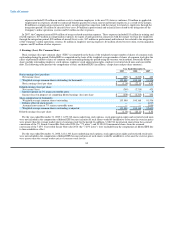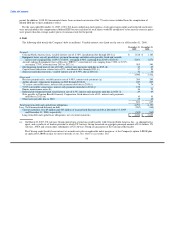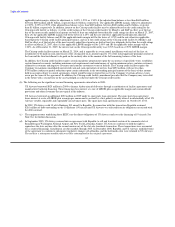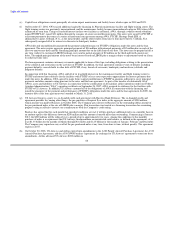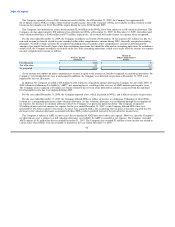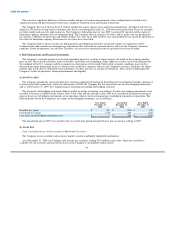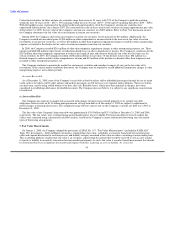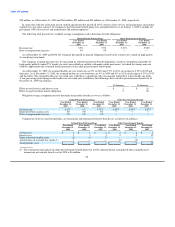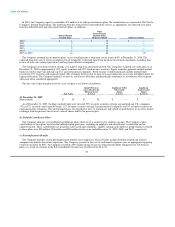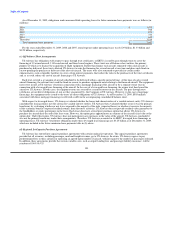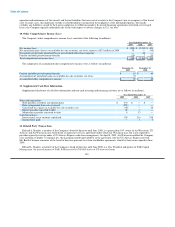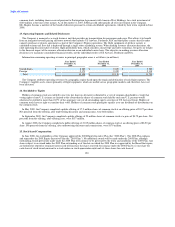US Airways 2009 Annual Report Download - page 97
Download and view the complete annual report
Please find page 97 of the 2009 US Airways annual report below. You can navigate through the pages in the report by either clicking on the pages listed below, or by using the keyword search tool below to find specific information within the annual report.
Table of Contents
Contractual maturities for these auction rate securities range from seven to 43 years, with 73% of the Company's portfolio maturing
within the next 10 years (2016 – 2017), 19% maturing within the next 30 years (2033 – 2036) and 8% maturing thereafter (2049 – 2052).
With the liquidity issues experienced in the global credit and capital markets, all of the Company's auction rate securities have
experienced failed auctions since August 2007. The estimated fair value of these auction rate securities no longer approximates par value.
At December 31, 2009, the fair value of the Company's auction rate securities was $203 million. Refer to Note 7 for discussion on how
the Company determines the fair value of its investments in auction rate securities.
During 2009, the Company sold certain investments in auction rate securities for net proceeds of $32 million. Additionally, the
Company recorded net unrealized gains of $58 million in other comprehensive income related to the increase in fair value of certain
investments in auction rate securities, as well as $10 million in other-than-temporary impairment charges recorded in other nonoperating
expense, net related to the decline in fair value of certain investments in auction rate securities.
In 2008, the Company recorded $214 million of other-than-temporary impairment charges in other nonoperating expense, net. These
charges included $48 million of previously recorded unrealized losses in other comprehensive income. The Company's conclusion for the
$214 million other-than-temporary impairment was due to the length of time and extent to which the fair value was less than cost for
certain securities. In 2007, the Company recorded a $58 million decline in fair value. Of this decline in fair value, $48 million was
deemed temporary and recorded to other comprehensive income and $10 million of the decline was deemed other-than-temporary and
recorded to other nonoperating expense, net.
The Company continues to monitor the market for auction rate securities and consider its impact (if any) on the fair value of its
investments. If the current market conditions deteriorate, the Company may be required to record additional impairment charges in other
nonoperating expense, net in future periods.
Accounts Receivable
As of December 31, 2009, most of the Company's receivables related to tickets sold to individual passengers through the use of major
credit cards or to tickets sold by other airlines and used by passengers on US Airways or its regional airline affiliates. These receivables
are short-term, mostly being settled within seven days after sale. Bad debt losses, which have been minimal in the past, have been
considered in establishing allowances for doubtful accounts. The Company does not believe it is subject to any significant concentration
of credit risk.
(c) Interest Rate Risk
The Company has exposure to market risk associated with changes in interest rates related primarily to its variable rate debt
obligations. Interest rates on $3.33 billion principal amount of long-term debt as of December 31, 2009 are subject to adjustment to
reflect changes in floating interest rates. The weighted average effective interest rate on the Company's variable rate debt was 3.98% at
December 31, 2009.
The fair value of the Company's long-term debt was approximately $3.95 billion and $3.31 billion at December 31, 2009 and 2008,
respectively. The fair values were estimated using quoted market prices where available. For long-term debt not actively traded, fair
values were estimated using a discounted cash flow analysis, based on the Company's current incremental borrowing rates for similar
types of borrowing arrangements.
7. Fair Value Measurements
On January 1, 2008, the Company adopted the provisions of SFAS No. 157, "Fair Value Measurements" (included in FASB ASC
Topic 320, Investments – Debt and Equity Securities), which defines fair value, establishes a consistent framework for measuring fair
value and expands disclosure for each major asset and liability category measured at fair value on either a recurring or nonrecurring basis.
This accounting guidance clarifies that fair value is an exit price, representing the amount that would be received to sell an asset or paid
to transfer a liability in an orderly transaction between market participants. As such, fair value is a market-based measurement that should
be determined based on assumptions that market participants would use in pricing an asset or liability. As a basis for
95


